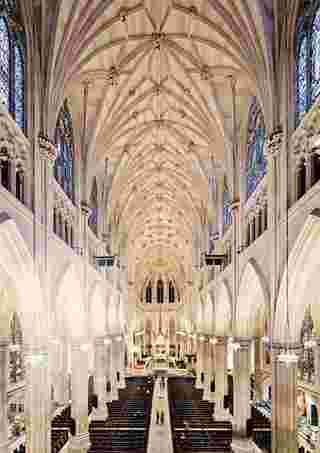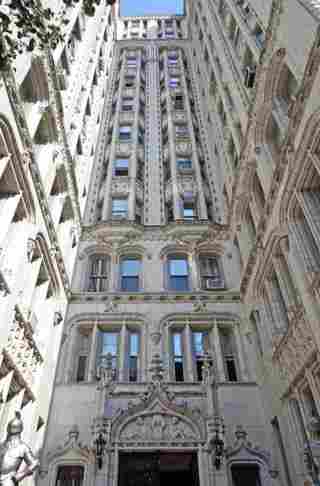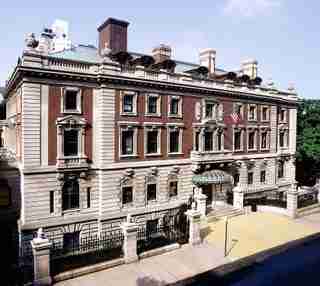If you find yourself in New York City , chances are you’ll run into at least one of these recently restored historic gems, all of which were honored by the New York Landmarks Conservancy earlier this spring. For the past 26 years the nonprofit has recognized the best restoration projects in the five boroughs via the Lucy G. Moses Preservation Awards. This year’s recipients can be found all over the city, even in Central Park, where a 3,500-year-old marble obelisk imported from Egypt shines anew after being cleaned with lasers. Other top projects are scattered across Staten Island, the Bronx, and Brooklyn, the last of which is home to the Coignet Stone Company Building—a pioneering 1872 structure brought back to life by Whole Foods Market . Honorees also include Barbaralee Diamonstein-Spielvogel, who received the Preservation Leadership Award, and the West End Preservation Society, which snagged the Preservation Organization Award. Architectural Digest has rounded up the rest of the winners here.

St. Patrick’s Cathedral, Manhattan
Completed just in time for Pope Francis’s visit last September, the $177 million restoration of St. Patrick’s Cathedral in midtown was the landmark’s first major overhaul in 70 years. New York architecture firm Murphy Burnham & Buttrick oversaw the three-year project, which touched nearly every part of the Gothic Revival masterpiece, designed by James Renwick Jr. and finished in 1879. Notably, 3,600 stained-glass panels were repaired and cleaned, as were the 9,200-pound bronze entry doors and the 330-foot-high twin spires that tower over Fifth Avenue.

36 Gramercy Park East, Manhattan
Architect James Riely Gordon embraced Gothic Revival ornamentation for this 1910 residential building on Gramercy Park, decorating the white glazed terra-cotta façade with shield motifs, winged grotesques, and corner rope moldings. The 12-story structure had been showing signs of age in recent years, so the owners tapped CTA Architects P.C. to give it a face-lift. The team disassembled and reset the entire roof-level cornice and rejuvenated the glazed surfaces, meticulously replicating the masonry work that couldn’t be salvaged.

36 Gramercy Park East, Manhattan
Architect James Riely Gordon embraced Gothic Revival ornamentation for this 1910 residential building on Gramercy Park, decorating the white glazed terra-cotta façade with shield motifs, winged grotesques, and corner rope moldings. The 12-story structure had been showing signs of age in recent years, so the owners tapped CTA Architects P.C. to give it a face-lift. The team disassembled and reset the entire roof-level cornice and rejuvenated the glazed surfaces, meticulously replicating the masonry work that couldn’t be salvaged.
High Bridge, Bronx
Originally constructed in 1848 as part of the Croton Aqueduct system, the 1,450-foot-long High Bridge, which crosses the Harlem River and connects the Bronx to Manhattan, is the city’s oldest span. It ceased functioning as an aqueduct in the 1950s, closing to pedestrians and sparking a decades-long decline that was only recently reversed thanks to the Parks Department, which has jurisdiction over the relic. After a $61 million renovation overseen by the local firm Li/Saltzman Architects, the bridge reopened last June, its signature granite arches refreshed and walkway ready for pedestrians and cyclists.
Central Park Obelisk, Manhattan
Created around 1425 B.C. in ancient Egypt, the Central Park Obelisk (commonly referred to as Cleopatra’s Needle) was once installed outside the Temple of the Sun in Heliopolis. Hewn from a single block of granite, the 70-foot-tall monument, which weighs 260 tons, came to New York in 1880 after a promise from the khedive of Egypt. Five years ago the Central Park Conservancy collaborated with the Metropolitan Museum of Art, Columbia University, and the World Monuments Fund to devise a treatment plan for the obelisk, which had previously undergone a series of ill-advised repairs. It has since become the largest and oldest monument to be laser cleaned, its hieroglyphs more legible and its granite free of grime.
Staten Island Museum, Staten Island
Constructed between 1833 and 1879, Snug Harbor, which is now a cultural complex, was originally a dormitory for former sailors. One of a grouping of five Greek Revival edifices, Building A, recently underwent a meticulous renovation funded by the Department of Cultural Affairs and managed by the Department of Design and Construction. Gluckman Tang Architects won the bid to oversee the transformation, breaking ground on the project in 2011. Because the landmark was in such disrepair, the firm added extensive steel-and-concrete framing inside while preserving its cast-iron pediments, lead-coated copper roof, and cupolas. The refurbished building includes four galleries, an auditorium, and classrooms, totaling 18,000 square feet of additional public space for the institution.
369th Regiment Armory Building, Manhattan
Designed by Van Wart & Wein in 1933, the 369th Regiment Armory Building in Manhattan’s northern reaches was built for the Harlem Hellfighters, the state’s first-ever African-American National Guard unit. Flanked by major highways, the Art Deco structure had accumulated years of soot, and its masonry details were deteriorating. Architectural and engineering firm STV came aboard in 2012 to help refresh the façade’s 2,000 pieces of terra-cotta ornamentation, including an exact recast of the twin eagles perched at the top of the building.
St. Paul’s Chapel and Churchyard, Manhattan
The oldest church in Manhattan, St. Paul’s dates from 1764 with a design attributed to Thomas McBean; the iconic 220-foot clock tower adjoining it was completed 30 years later. Located in the Financial District, the chapel served as a hub for 9/11 responders in the aftermath of the attacks, and the ensuing years saw a swell in the number of visitors. The building was clearly the worse for wear when Superstructures Engineers + Architects began its restoration in 2011. During the project, the famous clock was digitized and the steeple’s lead-coated copper portion was restored. Meanwhile, Mathews Nielsen Landscape Architects devised a sensitive plan to update the historic surrounding churchyard, addressing erosion and irrigation concerns.
Coignet Stone Company Building, Brooklyn
The 1872 Coignet Stone Company Building sat vacant in Gowanus for decades after it was abandoned in the 1950s by the Brooklyn Improvement Company. Designed by William Field and Son, the two-story structure is clad in Béton Coignet, a type of European concrete patented in the 1850s. Possibly the first example of cast-stone construction in the U.S., the building sits next to a new Whole Foods Market, which acquired the adjacent plot in 2005 on the condition that it revive the derelict historic structure as well. The renovation removed years of faux brick and cementitious paint, and the building now gleams thanks to a limewash coating.
Floyd Bennett Field Hangars 1 & 2, Brooklyn
Listed on the National Register of Historic Places, these Art Deco hangars were completed in 1931 and are located within the sprawling Gateway National Recreation Area. Until last year they had sat unused for decades under the control of the National Park Service, which spearheaded the recent rehabilitation along with AECOM. A consortium including RAAD Construction Group, Williams Companies, BL Companies outfitted the structures so they would be able to safely house energy services equipment. The resulting design matches archival images exactly, down to lettered graphics on the gabled fascia.
Old Brooklyn Fire Headquarters, Brooklyn
This stately Romanesque Revival structure, constructed in 1892 as the headquarters of the Fire Department of the City of Brooklyn, was converted into affordable housing in the 1980s. The building had deteriorated substantially over the years as repairs went unmade, but thanks to the Pratt Area Community Council (now Impacct Brooklyn), a restoration by Brooklyn-based Nomad Architecture was implemented. The building’s signature red sandstone arch was completely reconstructed, while turrets, which once sprouted plants, were topped with terra-cotta units matching the originals.
Piros Residence, Brooklyn
A rare surviving example of a townhouse clad in wood coated to simulate brownstone, this Italianate residence was completed around 1874 and is located in the Crown Heights North Historic District. The current homeowners purchased the property in 2004 and enlisted the New York–based architecture firm Gormanschweyer for a major overhaul, including a restoration of the original wood façade, which was painted in a 19th-century technique that added sand to paint to mimic the appearance of brownstone. The team also added a stoop that matched historical photographs of the home.
